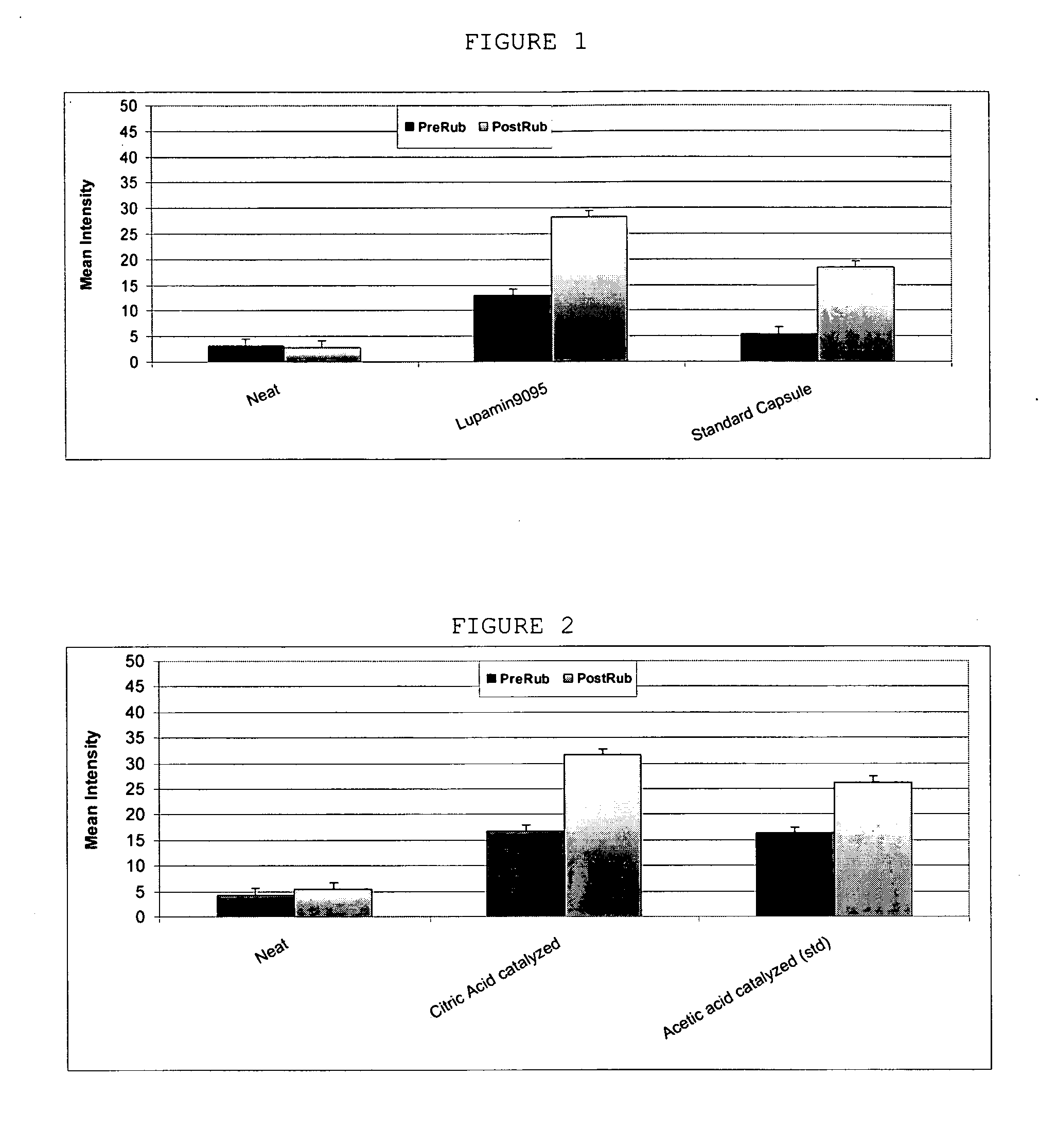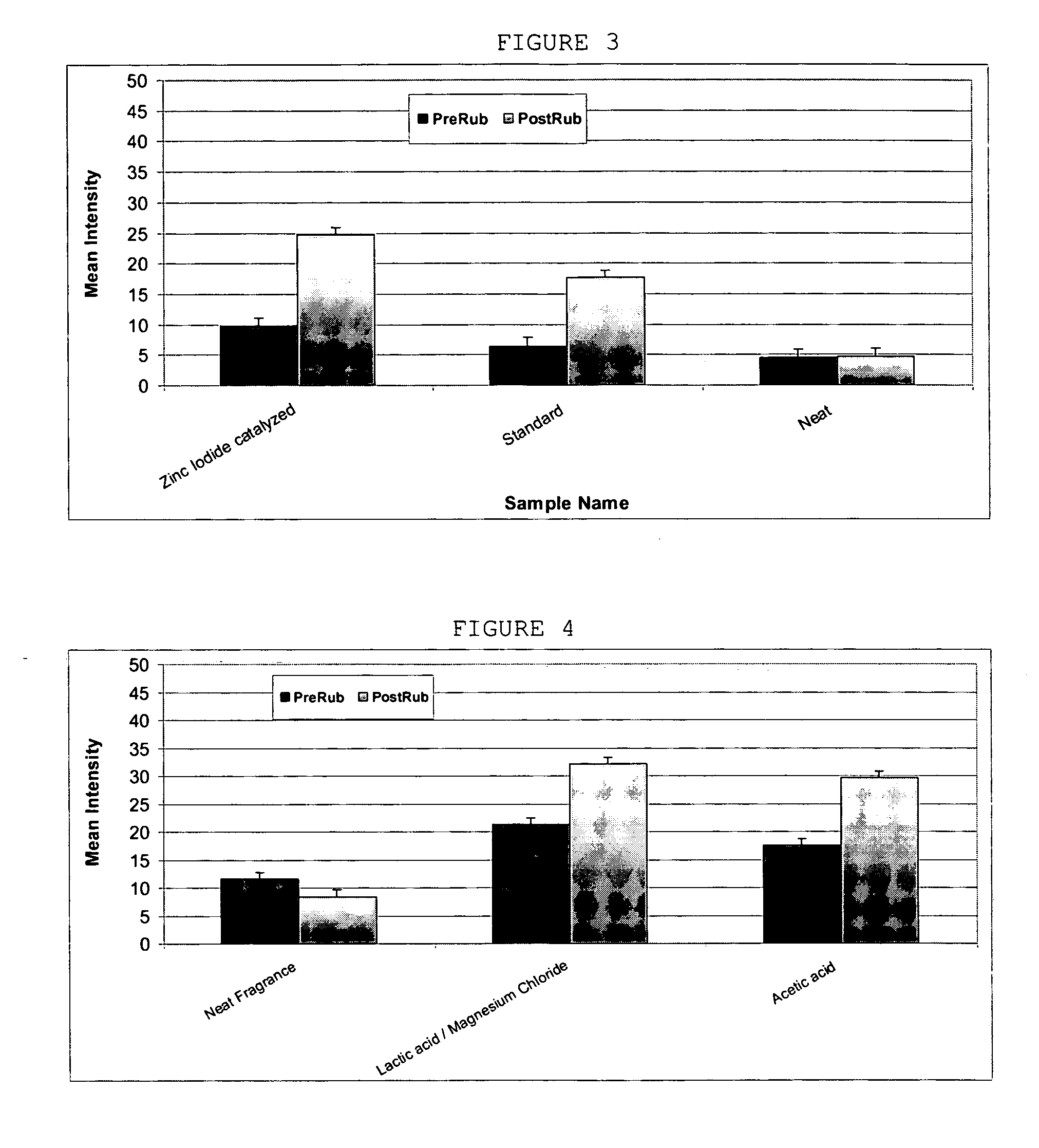Encapsulated fragrance materials and methods for making same
a fragrance material and encapsulation technology, applied in the field of capsules, can solve the problems of not being able to significantly improve the fragrance performance of consumer products, not wanting the core to be released from the shell prematurely, and physical forces can affect the performance of the capsule, etc., and achieve the effect of enhancing deposition
- Summary
- Abstract
- Description
- Claims
- Application Information
AI Technical Summary
Benefits of technology
Problems solved by technology
Method used
Image
Examples
example i
Naturally-Derived Amine Containing Polymer
[0230] 6.8 g of gelatin (Type A, 300 bloom) and 320.2 g water were combined and heated to between 50 and 60° C. until the gelatin dissolved. 18 g of Cymel 385 were then added and the mixture stirred until clear. The pH was adjusted to 4 with 10M HCl. 134 g of core material containing 67 g of fragrance oil and 67 g of modifier (Neobee M-5 oil) were emulsified until the particle size was between 10 and 20 μm. The emulsion was then heated to 80° C. and held at 80° C. for 2 hours. After cooling fragrance microcapsules were obtained. The mean capsule size was 12.7 μm and the encapsulation efficiency was 96.50%. The capsules were incorporated in fabric conditioner. Cloths washed with this fabric conditioner exhibited enhanced fragrance levels and burst effects compared to cloths washed with neat fragrance.
example ii
Synthetic Amine Containing Polymer
[0231] 34 g of Lupamin 9095, 18 g Cymel 385 (available from Cytec), and 293 g water were combined and stirred until dissolved. The pH was left in a natural state at about 8. The mixture was held at 50° C. for approximately 135 minutes, at which time 168 g of core material containing 84 g of fragrance oil and 84 g of modifier (Neobee M-5 oil) were added. The mixture was emulsified until the particle size was between 10 and 20 μm, and then heated to 80° C. and held there for 2 hours. After cooling, fragrance microcapsules were obtained. The mean capsule size was 15.3 μm and the encapsulation efficiency was 99.34%. The capsules were incorporated in fabric conditioner. Cloths washed with this fabric conditioner exhibited enhanced fragrance levels and burst effects compared to cloths washed with neat fragrance, see FIG. 1.
example iii
Acid Catalyst
[0232] A reactor was charged with 34 g of Alcapsol 144 (Ciba), 18 g of Cymel 385 (available from Cytec), and 293 g of water. This mixture was stirred until a clear solution with an approximate pH of 6.3 was obtained. Citric acid crystals are added stepwise with dissolving until pH of 5 is reached. This mixture was then stirred for 1 hour at 23° C. at which time 210 g of the fragrance core consisting of 105 g of fragrance accord and 105 g of Neobee M-5 oil was added and the mixture high-sheared until a mean droplet size of 8 μm was reached. The temperature was raised to 80° C. for 2 hours to cure the microcapsules. After cooling a white slurry was obtained. Upon incorporation into fabric conditioner base performance was found to be the same or better than the standard acetic acid catalyzed process, see FIG. 2.
PUM
| Property | Measurement | Unit |
|---|---|---|
| time | aaaaa | aaaaa |
| time | aaaaa | aaaaa |
| time | aaaaa | aaaaa |
Abstract
Description
Claims
Application Information
 Login to View More
Login to View More - R&D
- Intellectual Property
- Life Sciences
- Materials
- Tech Scout
- Unparalleled Data Quality
- Higher Quality Content
- 60% Fewer Hallucinations
Browse by: Latest US Patents, China's latest patents, Technical Efficacy Thesaurus, Application Domain, Technology Topic, Popular Technical Reports.
© 2025 PatSnap. All rights reserved.Legal|Privacy policy|Modern Slavery Act Transparency Statement|Sitemap|About US| Contact US: help@patsnap.com



